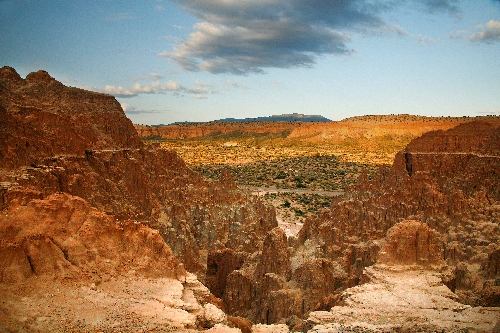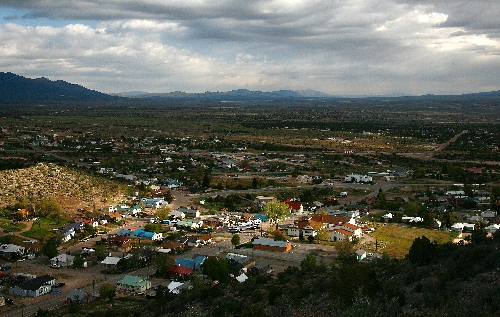Where the West Isn’t Vanishing
Las Vegas is full of people who moved here for the nightlife, but I'm not one of them. I came because living here lets me access the rural West on short notice and sometimes on short money. In 40 years of enjoying that practice, I've never found a better place to do it than Lincoln County, northeast of Las Vegas.
Last weekend I got to do it again, accompanied by my spouse, Patricia, and son, Ash, 28.
The colorful and once-violent history of the Lincoln County seat, Pioche, had been my original fascination with the area, but lately I had been talking to Don Shanks, a member of the Lincoln County Chamber of Commerce, who said most visitors now come for outdoor attractions. He spoke of good fishing at Eagle Valley Reservoir, actual beaver seen lately at Beaver Dam State Park and antelope herds bounding over the flat country along U.S. 93 north of Pioche. So Saturday morning, we were rolling north on U.S. 93 -- the Great Basin Highway -- looking for antelope or adventure. By early afternoon, we were listening to the restful rustle of cottonwood leaves overhead, punctuated by the whoops of children swimming in the natural Panaca Hot Spring.
"There can be snow on the ground, and there'll be steam rising off the water, but it's still warm enough to go in," said Steffanie Thornock, who had brought her three young children out for a splash. The hot spring is the source of the community's irrigation water and has been dammed to augment that purpose. That makes it deeper than most Nevada hot springs, deep enough to swim. Community groups use it to run mini-iron man races. "And we also use it to settle bets," said Thornock. "I lost a racquetball game and had to jump in."
This is not, she noted, one of the clothing-optional springs of legend. The town of Panaca, founded in 1864 by Mormon missionaries, has clung ever since to family values.
That character set it in sharp contrast to its nearest neighbor, Pioche, in the latter's early years, when Pioche was famed for wickedness. The 14 ensuing decades have tamed Pioche remarkably, but a special charm of Lincoln County is that each community retains a distinctively different ambience, rooted in distinctively different beginnings.
The Mormon Prophet Brigham Young ordered an agricultural settlement in the rich, wide Meadow Valley, then believed to be part of Utah. The town of Panaca was established in 1864, and its relation to Salt Lake City, with a grid of wide streets and a planned pattern of commercial, church, and civic functions, remains visible to this day.
A Paiute man showed silver ore to missionary William Hamblin, who then staked the region's first successful claim. Word of silver brought other prospectors, few of these especially motivated by religious devotion, and some discovered claims a few miles away on a mountain later named Treasure Hill. Because a San Francisco financier, Francois Pioche, came up with the money to build smelters and otherwise develop this site, the ensuing town was named for him.
From 1869, Pioche boomed most of a decade, and obtaining fuel for its smelters was a constant logistical problem. Last weekend, we visited two relics of that effort, the Panaca Summit Charcoal Kilns. From its intersection with U.S. 93, we took Nevada Highway 319 east for 13.3 miles, through the town of Panaca and across the first range of mountains. Just beyond the 6,120-foot Panaca Summit, we found the left turn across a cattle guard that led 4.8 miles into the hills and to the kilns.
Charcoal burned twice as hot as cordwood and was easier to transport. Skillfully built of dressed stone and mortar, the kilns look about as high as two-story houses. Workers called "charcoal burners," usually Swiss and Italian immigrants, filled them with five-foot lengths of wood cut from surrounding mountains. Once the wood was set afire, the kiln was partially sealed to control the rate of burning.
It took as much as 30 days to make charcoal, and 50 cords of wood produced only 30 bushels. That was enough to smelt only one ton of the very heavy Pioche ore. Charcoal workers were poorly paid, but these kilns continued in use until the 1890s. Such kilns were once seen all over the West, but few remain, and the two at Panaca Summit are among the best preserved.
That night, we stayed in Pioche's Overland Hotel, noted for a magnificent backbar with big mirrors and great wooden columns, and a hardwood frontbar so long that a gunslinger at the far end would have been out of range.
Jim Kelly is a tour guide in Pioche's principal historic attraction, the "Million Dollar Courthouse," so called because building costs, financing, and graft quickly outran $75,000 budgeted in 1872. I monopolized the guide's time over a libation at the Overland, while he told me that in its early years, Pioche fully deserved its bad reputation.
"But it's different nowadays," said Kelly. "The last time I heard sirens in Pioche, I went to see what was going on, and the fire department's volunteers were all dressed up like Easter bunnies, giving children rides to the egg hunt."
Besides the Overland, at least one other saloon still prospers here. Jim Marsh, a Las Vegas auto dealer famed for acquiring and saving historic Nevada buildings, recently added to his collection Pioche's venerable watering hole, The Alamo. He spruced it up and renamed it the Bank Club.
We turned in early. The Overland's rooms, formerly noted for 1940s nostalgia, have been redecorated and refurnished. Our spacious accommodation was "The Garden Suite," and it lived up to its airy name with white wicker furniture, flowered quilts, floral paintings and swell high-thread-count sheets.
One of the welcome modern changes to Lincoln County has been that every village now has adequate lodgings, some even luxurious. We visited the Pine Tree Inn and Bakery in Panaca, opened in 2000 by rancher Robert Mathews and his wife, Carol, a former school teacher, in the home where he grew up. It's the only bed-and-breakfast in Panaca, and typical guests, said Mathews, are couples who stay there while exploring the surrounding country by ATV. "I lead the rides myself, so these are not about high-jumping over banks. They're low-speed, close-up looks at nature."
The next town south of Panaca, Caliente, was a product of the industrial age, built in 1905 to serve a railroad that also gave birth to Las Vegas the same year. The most impressive building in town is the former rail depot, a Mission Revival structure built in 1923. Nowadays, it serves as the Caliente city hall. Conversion from steam to diesel-electric ended the need for most railroad jobs in Caliente, and the opening of Nevada Route 318, a faster north-south route than U.S. 93, diverted the hurry-up through traffic from which Caliente motels and restaurants had prospered. But the section of U.S. 93 so bypassed -- 148 miles from Crystal Springs to Ely -- was also the most beautiful and is now recognized as the Great Basin Scenic Byway. One May morning, I saw five golden eagles while driving its lower 67 miles. Enough travelers take the scenic route to keep several Caliente motels open.
On Saturday, Caliente will be the jumping-off-point for Lincoln County Trails Day, an organized event designed to help participants enjoy the back country safely and responsibly, whether by OHV, four-wheel-drive, horse or human foot. Not far from Caliente lies the most popular access point on the Silver State Trail, a 260-mile route designated by Congress in 2004 for OHV use.
We had planned on another day outdoors in the Lincoln County climate, which is usually agreeable in months when Las Vegas simmers. But at 6,060 feet, Pioche was a little too cool on Sunday morning; it was snowing when Ash got up early to photograph nearby Cathedral Gorge at sunrise. So we headed home, stopping briefly at the county's southernmost significant civilization, the village of Alamo, about 95 miles from Las Vegas. Officially founded in 1901, Alamo has always been a ranching community. Lately, it's become known for a spectacular luxury bed and breakfast called The Cowboy's Dream.
The manager, Ginger Tharpe, met us in a great room big enough to hold a small rodeo.
Tharpe explained that her friend, Phyllis Frias, built the place as a memorial to her late husband, the Vegas transportation magnate Charles Frias. Tharpe, a former furniture dealer, bought some of the furniture, had the rest built to order, and was deeply involved in the overall design.
"Charles Frias was a Texan, so we decided to build it in a place named Alamo," Tharpe explained.
Guests dine formally in the evening and informally at breakfast; some spend their days riding horses or OHVs, but many simply unwind in the utterly comfortable suites, built with no walls in common for absolute privacy.
We would have lingered longer ourselves, but had to leave in time to photograph Upper Pahranagat Lake, a wildlife-rich refuge south of Alamo, in the sunset. As we drove the dirt road along the east shore, thousands of tiny birds, with light-colored bodies and short pointed wings, darted around us in pursuit of insects. I couldn't decide if they were white-throated swifts or violet green swallows, but they could out-fly a British Spitfire fighter.
The Hopkins elders stayed in the car while our photographer son raced the dusk, and low gathering clouds, chasing a perfect Pahranagat image. I was already thinking ahead to pleasures in Lincoln County this summer. Sheltered from the wind, I daydreamed of wildflowers, a beer in the Overland Bar, and antelope dashing over a sagebrush flat somewhere north of Pioche.
Contact A.D. Hopkins at adhopkins@reviewjournal.com or 702-383-0270.


















